A Framework of Hybrid Method for Developing Optimal Sustainable Product Strategies and Sustainable Product Roadmap
Abstract
1. Introduction
2. Literature Review of Relevant Technologies
2.1. The Tool for Developing Sustainable Product Strategies
2.2. The SPSFG
2.3. Brainstorming
2.4. The WDM
2.5. The GA
2.6. The Sustainable Product Roadmap
3. The Framework of Hybrid Method Derived from SPSFG, Brainstorming, WDM, and GA Technologies for Creating Sustainable Product Strategies and Sustainable Roadmap
- Preliminary Sustainable Product Strategies Development
- 2.
- Evaluation of Preliminary Sustainable Product Strategies
- 3.
- Generation of the Best Sustainable Product Strategies Portfolio
- 4.
- Building Roadmap of the Best Sustainable Product Strategies Portfolio
4. Methods
4.1. Preliminary Sustainable Product Strategies Development
- Organizing SPSFG
- Preparing the sustainable product strategies category cards
- Creating preliminary sustainable product strategies through brainstorming
4.2. Evaluation of Preliminary Sustainable Product Strategies
- Building WDM
- Determine best sustainable product strategies through WDM
4.3. Generation of the Optimal Sustainable Product Strategies Portfolio
4.4. Building Roadmap of the Optimal Sustainable Product Strategies Portfolio
4.5. Verifying the Framework of Hybrid Method
5. Results
5.1. 3C Products’ Preliminary Sustainable Product Strategies Created by SPSFG
- 1.
- Energy Efficiency:
- ✓
- Similarities: Strategies 1, 12, and 22 all focus on optimizing energy use either through energy-efficient designs or the integration of smart technologies.
- ✓
- Differences: Strategy31 stands out by aiming to design products that generate more energy than they consume.
- 2.
- Eco-friendly Materials:
- ✓
- Similarities: Strategies 21, 23, and 33 emphasize the use of sustainable and renewable materials in product design.
- ✓
- Differences: Strategy33 goes further by exploring materials with a carbon-negative footprint.
- 3.
- Modular Design:
- ✓
- Similarities: Strategies 3, 26, and 32 promote product modularity, either for repair and upgradeability or through closed-loop systems.
- ✓
- Differences: Strategy32 introduces upgradable software as a means of extending product lifespan.
- 4.
- Recycling Programs:
- ✓
- Similarities: Strategies 5, 15, 26, and 39 all address the responsible disposal of electronic waste.
- ✓
- Differences: Strategy39 takes a collaborative approach, involving competitors for industry-wide recycling initiatives.
- 5.
- Renewable Energy Integration:
- ✓
- Similarities: Strategies 5, 21, 31, and 36 integrate renewable energy sources into product functionality.
- ✓
- Differences: Strategy36 focuses on energy storage solutions to promote efficient energy use.
- 6.
- Longevity and Durability:
- ✓
- Similarities: Strategies 6 and 29 emphasize durability to reduce the need for frequent replacements.
- ✓
- Differences: Strategy29 adopts minimalist design principles to reduce material usage.
- 7.
- Reduced Packaging Waste:
- ✓
- Similarities: Strategies 7, 21, and 37 aim to minimize packaging waste through eco-friendly materials and designs.
- ✓
- Differences: Strategy37 sets the ambitious goal of zero-waste packaging.
- 8.
- Supply Chain Sustainability:
- ✓
- Similarities: Strategies 8, 18, and 38 focus on sustainable and ethical practices within the supply chain.
- ✓
- Differences: Strategy38 seeks fair trade certification to ensure fair wages and ethical treatment.
- 9.
- Lifecycle Assessments:
- ✓
- Similarities: Strategy9 is unique in its focus on conducting life-cycle assessments to minimize environmental impact.
- 10.
- Carbon Footprint Reduction:
- ✓
- Similarities: Strategies 10 and 33 address the reduction in carbon footprints, with Strategy10 investing in offset programs.
- ✓
- Differences: Strategy33 focuses on carbon-negative materials.
- 11.
- User Education and Engagement:
- ✓
- Similarities: Strategies 11 and 31 aim to educate consumers about the environmental impact of products.
- ✓
- Differences: Strategy11 emphasizes responsible use, disposal, and recycling.
5.2. 3C Products’ Best Sustainable Product Strategies Determined by WDM
5.3. 3C Products’ Optimal Sustainable Product Strategies Combination Portfolio Chosen from GA
5.4. Roadmap of Sustainable Product Strategies of 3C Products
- 1.
- Phase 1: Foundation (Months 1–3)
- ✓
- Define Sustainability Goals and Metrics
- (A)
- Establish clear and measurable sustainability objectives based on the identified strategies.
- (B)
- Set key performance indicators (KPIs) for each strategy to track progress.
- ✓
- Internal Training and Awareness
- (A)
- Educate the internal team about the importance of sustainability in product development.
- (B)
- Conduct workshops on the specific strategies and their implications.
- 2.
- Phase 2: Research and Analysis (Months 4–6)
- ✓
- Market and Competitor Analysis
- (A)
- Research competitors’ sustainable practices.
- (B)
- Identify market trends and demands related to eco-friendly products.
- ✓
- Life-Cycle Assessment
- (A)
- Conduct a thorough life-cycle assessment of the product to identify environmental impacts.
- (B)
- Prioritize strategies based on impact and feasibility.
- 3.
- Phase 3: Sustainable Design Principles (Months 7–12)
- ✓
- Modular Design Integration (Strategy 3)
- (A)
- Implement modular design principles to enhance product flexibility and upgradeability.
- (B)
- Train design and development teams on modular design concepts.
- ✓
- Longevity and Durability (Strategy 6)
- (A)
- Optimize product design for longevity and durability.
- (B)
- Explore materials and manufacturing processes that enhance product lifespan.
- ✓
- Reduced Material Usage (Strategy 29)
- (A)
- Adopt minimalist design principles to reduce overall material usage.
- (B)
- Prioritize simplicity without compromising functionality and user experience.
- 4.
- Phase 4: Sustainable Production (Months 13–18)
- ✓
- Localized Production (Strategy 24)
- (A)
- Establish localized manufacturing facilities to reduce the environmental impact of transportation.
- (B)
- Promote regional job creation and support local economies.
- ✓
- Energy-Efficient Manufacturing (Strategy 22)
- (A)
- Implement energy-efficient practices to reduce energy consumption during production.
- (B)
- Optimize production lines to minimize waste and enhance overall energy efficiency.
- ✓
- Closed-Loop Systems (Strategy 26)
- (A)
- Implement closed-loop systems for the recovery and reuse of materials.
- (B)
- Design products with easily reintegrated components.
- 5.
- Phase 5: Sustainable Distribution and Transparency (Ongoing)
- ✓
- Energy-Storage Integration (Strategy 36)
- (A)
- Integrate energy storage solutions into products for efficient energy use and storage.
- (B)
- Explore partnerships with renewable energy companies for comprehensive energy solutions.
- ✓
- Blockchain for Supply Chain Transparency (Strategy 40)
- (A)
- Implement blockchain technology to enhance transparency in the supply chain.
- (B)
- Enable consumers to trace the journey of the product from raw materials to end-of-life recycling.
- ✓
- Incentives for Sustainable Choices (Strategy 17)
- (A)
- Develop a rewards program for customers making sustainable choices.
- (B)
- Explore partnerships with eco-friendly organizations for joint promotions.
- 6.
- Phase 6: Post-Launch and Continuous Improvement (Ongoing)
- ✓
- User Education and Engagement (Strategy 11)
- (A)
- Develop educational materials for users on sustainable product use.
- (B)
- Engage with customers through social media and other channels.
- ✓
- Continuous Improvement (Strategy 18)
- (A)
- Gather feedback on sustainability initiatives and product performance.
- (B)
- Iterate on strategies based on feedback and technological advancements.
5.5. Verification Results of Hybrid Method
6. Discussion
6.1. Framework of Hybrid Method
6.2. Sustainable Product Strategies of 3C Products
- 1.
- Scope and Vision:
- 3C Product Strategy: concentrates on meeting consumer demands and gaining a competitive edge within a specific market, which is often driven by trends and technological advancements.
- Sustainable Product Strategies: encompasses a comprehensive framework that transcends immediate business considerations, emphasizing a vision rooted in environmental stewardship, ethics, and global responsibility.
- 2.
- Environmental Considerations:
- 3C Product Strategy: may incorporate technology and innovation but may not explicitly prioritize environmental concerns unless demanded by the market.
- Sustainable Product Strategies: prioritizes environmental sustainability through energy efficiency, eco-friendly materials, modular design, recycling programs, renewable energy integration, and circular economy principles.
- 3.
- Ethics and Responsibility:
- 3C Product Strategy: primarily aims at satisfying consumer needs and gaining a competitive advantage with less emphasis on ethical and responsible business practices.
- Sustainable Product Strategies: highlights a commitment to ethical practices, fair labor, and responsible business conduct throughout the product life cycle, reflecting a deeper understanding of global impact.
- 4.
- Innovation and Technology:
- 3C Product Strategy: emphasizes technical capabilities, user experience, and innovation to meet evolving consumer expectations and gain a competitive advantage.
- Sustainable Product Strategies: integrates smart technology and artificial intelligence not just for product enhancement but also for addressing environmental concerns and contributing to a regenerative approach.
- 5.
- Consumer Focus:
- 3C Product Strategy: centers on understanding and meeting the specific needs and behaviors of target customers, often driven by market demands.
- Sustainable Product Strategies: extends beyond market demands to educate and engage consumers in sustainable practices, acknowledging the interconnectedness between product design and the broader ecosystem.
- 6.
- Long-Term Perspective:
- 3C Product Strategy: primarily concerned with immediate market positioning and gaining a competitive edge.
- Sustainable Product Strategies: exemplifies a collective awakening to the imperative of sustainable and responsible practices, indicating a long-term perspective beyond current market trends.
6.3. Roadmap of Sustainable Product Strategies of 3C Products
7. Conclusions
Funding
Institutional Review Board Statement
Informed Consent Statement
Data Availability Statement
Conflicts of Interest
Appendix A. Content of SDGs
| No. | Goal’s Name | Content |
|---|---|---|
| Goal 1 (G1) | No Poverty | End poverty in all its forms everywhere. |
| Goal 2 (G2) | Zero Hunger | End hunger, achieve food security and improved nutrition, and promote sustainable agriculture. |
| Goal 3 (G3) | Good Health and Well-Being | Ensure healthy lives and promote well-being for all at all ages. |
| Goal 4 (G4) | Quality Education | Ensure inclusive and equitable quality education and promote lifelong learning opportunities for all. |
| Goal 5 (G5) | Gender Equality | Achieve gender equality and empower all women and girls. |
| Goal 6 (G6) | Clean Water and Sanitation | Ensure availability and sustainable management of water and sanitation for all. |
| Goal 7 (G7) | Affordable and Clean Energy | Ensure access to affordable, reliable, sustainable and modern energy for all. |
| Goal 8 (G8) | Decent Work and Economic Growth | Promote sustained, inclusive and sustainable economic growth, full and productive employment and decent work for all. |
| Goal 9 (G9) | Industry, Innovation and Infrastructure | Build resilient infrastructure, promote inclusive and sustainable industrialization, and foster innovation. |
| Goal 10 (G10) | Reduced Inequalities | Reduce income inequality within and among countries. |
| Goal 11 (G11) | Sustainable Cities and Communities, Responsible Consumption and Production | Make cities and human settlements inclusive, safe, resilient, and sustainable. |
| Goal 12 (G12) | Responsible Consumption and Production | Ensure sustainable consumption and production patterns. |
| Goal 13 (G13) | Climate Action, Goal | Take urgent action to combat climate change and its impacts by regulating emissions and promoting developments in renewable energy. |
| Goal 14 (G14) | Life Below Water | Conserve and sustainably use the oceans, seas and marine resources for sustainable development. |
| Goal 15 (G15) | Life on Land, Goal | Protect, restore and promote sustainable use of terrestrial ecosystems, sustainably manage forests, combat desertification, and halt and reverse land degradation and halt biodiversity loss. |
| Goal 16 (G16) | Peace, Justice and Strong Institutions | Promote peaceful and inclusive societies for sustainable development, provide access to justice for all and build effective, accountable and inclusive institutions at all levels. |
| Goal 17 (G17) | Partnerships for the Goals | Strengthen the means of implementation and revitalize the global partnership for sustainable development. |
Appendix B. Preliminary Sustainable Product Strategies and Their Definition
| No. | Name of strategy | Definition of Strategy |
|---|---|---|
| 1 | Strategy1 Energy Efficiency |
|
| 2 | Strategy2 Eco-friendly Materials |
|
| 3 | Strategy3 Modular Design |
|
| 4 | Strategy4 Recycling Programs |
|
| 5 | Strategy5 Renewable Energy Integration |
|
| 6 | Strategy6 Longevity and Durability |
|
| 7 | Strategy7 Reduced Packaging Waste |
|
| 8 | Strategy8 Supply Chain Sustainability |
|
| 9 | Strategy9 Lifecycle Assessments |
|
| 10 | Strategy10 Carbon Footprint Reduction |
|
| 11 | Strategy11 User Education and Engagement |
|
| 12 | Strategy12 Smart Technology Integration |
|
| 13 | Strategy13 Water Conservation |
|
| 14 | Strategy14 Fair Labor Practices |
|
| 15 | Strategy15 E-Waste Reduction |
|
| 16 | Strategy16 Collaboration for Impact |
|
| 17 | Strategy17 Incentives for Sustainable Choices |
|
| 18 | Strategy18 Continuous Improvement |
|
| 19 | Strategy19 Transparency and Reporting |
|
| 20 | Strategy20 Circular Economy Integration |
|
| 21 | Strategy21 Renewable Packaging Materials |
|
| 22 | Strategy22 Energy-Efficient Manufacturing Processes |
|
| 23 | Strategy23 Biodegradable Product Components |
|
| 24 | Strategy24 Localized Production |
|
| 25 | Strategy25 Sustainable Product Upcycling |
|
| 26 | Strategy26 Closed-Loop Systems |
|
| 27 | Strategy27 Waterless Manufacturing |
|
| 28 | Strategy28 Biodiversity Conservation |
|
| 29 | Strategy29 Minimalist Design |
|
| 30 | Strategy30 Social Impact Initiatives |
|
| 31 | Strategy31 Energy-Positive Products |
|
| 32 | Strategy32 Upgradable Software |
|
| 33 | Strategy33 Carbon-Negative Materials |
|
| 34 | Strategy34 Community Engagement in Product Design |
|
| 35 | Strategy35 Sustainable Transportation Solutions |
|
| 36 | Strategy36 Energy-Storage Integration |
|
| 37 | Strategy37 Zero-Waste Packaging |
|
| 38 | Strategy38 Fair Trade Certification |
|
| 39 | Strategy39 Collaborative Product Recycling |
|
| 40 | Strategy40 Blockchain for Supply Chain Transparency |
|
Appendix C. Number of WDM Weights of 3C Products’ Sustainable Product Strategies
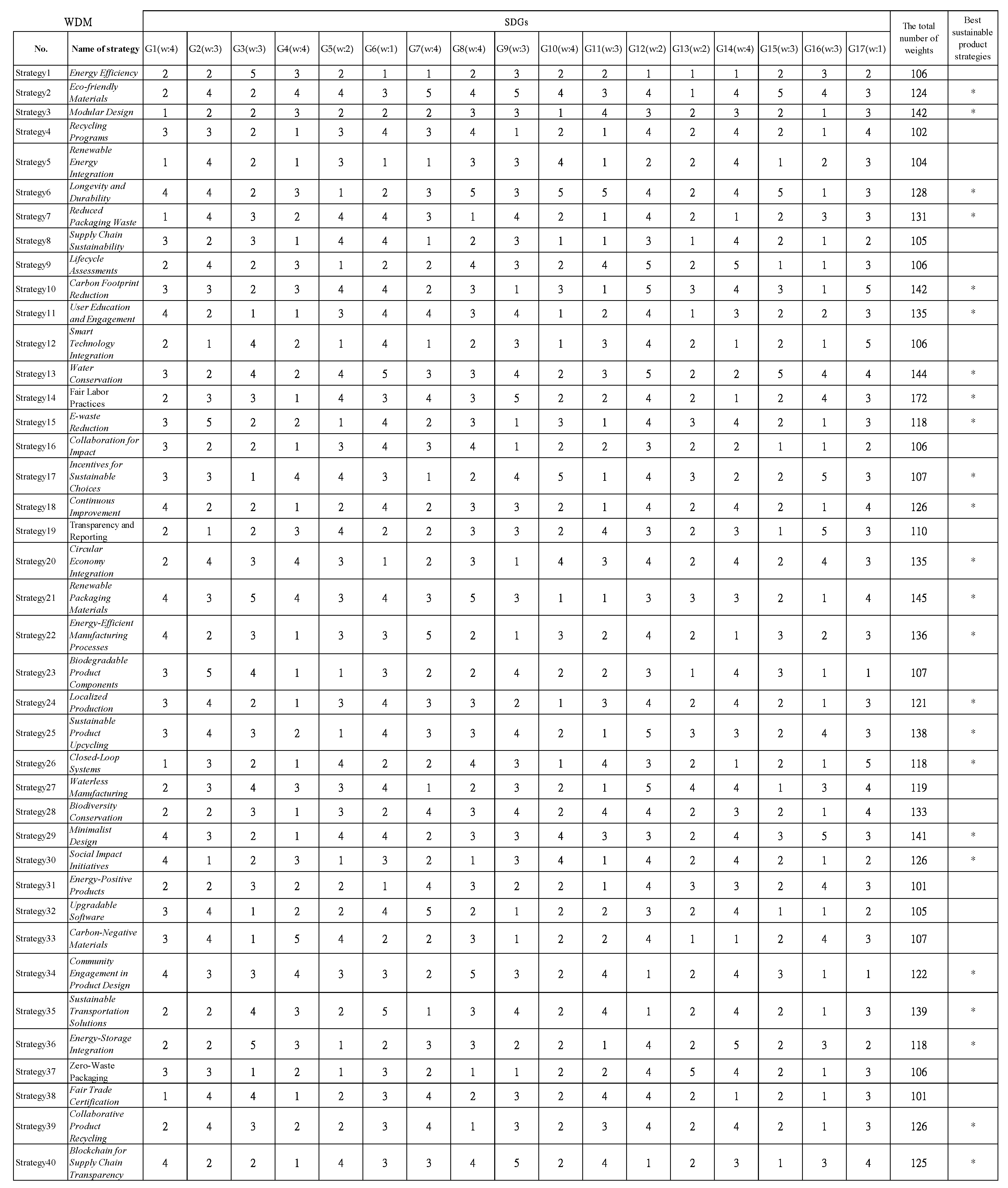
References
- Ciroth, A.; Finkbeiner, M.; Traverso, M.; Hildenbrand, J.; Kloepffer, W.; Mazijn, B.; Prakash, S.; Sonnemann, G.; Valdivia, S.; Ugaya, C.M.L.; et al. Towards a Life Cycle Sustainability Assessment: Making Informed Choices on Products; UN Environment Programme: Paris, France, 2011; p. 2011. [Google Scholar]
- De Medeiros, J.F.; Ribeiro, J.L.D.; Cortimiglia, M.N. Success factors for environmentally sustainable product innovation: A systematic literature review. J. Clean. Prod. 2014, 65, 76–86. [Google Scholar] [CrossRef]
- Dangelico, R.M.; Pujari, D. Mainstreaming Green Product Innovation: Why and How Companies Integrate Environmental Sustainability. J. Bus. Ethics 2010, 95, 471–486. [Google Scholar] [CrossRef]
- Yazirlıoğlu, L. Sustainable Design Considerations for Emotional Durability Product Longevity through Product Care Activities by Repair Enthusiasts. Master’s Thesis, Graduate School of Natural and Applied Sciences, Isparta, Türkiye, 2021. [Google Scholar]
- Ramani, K.; Ramanujan, D.; Bernstein, W.Z.; Zhao, F.; Sutherland, J.; Handwerker, C.; Choi, J.; Kim, H.; Thurston, D. Integrated Sustainable Life Cycle Design: A Review. J. Mech. Des. 2010, 132, 091004. [Google Scholar] [CrossRef]
- Charter, M.; Tischner, U. Sustainable Solutions: Developing Products and Services for the Future; Routledge: Oxford, UK, 2017. [Google Scholar]
- Rashid, L.; Yahya, S.; Shamee1, S.A.; Jabar1, J.; Sedek, M.; Halim1, S. Eco product innovation in search of meaning: Incremental and radical practice for sustainability development. Asian Soc. Sci. 2014, 10, 78–88. [Google Scholar] [CrossRef]
- Branco, M.C.; Rodrigues, L.L. Corporate Social Responsibility and Resource-Based Perspectives. J. Bus. Ethics 2006, 69, 111–132. [Google Scholar] [CrossRef]
- Chatty, T.; Harrison, W.; Ba-Sabaa, H.H.; Faludi, J.; Murnane, E.L. Co-Creating a Framework to Integrate Sustainable Design into Product Development Practice: Case Study at an Engineering Consultancy Firm. Sustainability 2022, 14, 9740. [Google Scholar] [CrossRef]
- Niemann, J.; Tichkiewitch, S.; Westkämper, E. Design of Sustainable Product Life Cycles; Springer Science & Business Media: Berlin/Heidelberg, Germany, 2008. [Google Scholar]
- Zhang, H.C.; Kuo, T.C.; Lu, H.; Huang, S.H. Environmentally conscious design and manufacturing: A state-of-the-art survey. J. Manuf. Syst. 1997, 16, 352–371. [Google Scholar] [CrossRef]
- Hartman, L.P.; Rubin, R.S.; Dhanda, K. The Communication of Corporate Social Responsibility: United States and European Union Multinational Corporations. J. Manuf. Syst. 2007, 74, 373–389. [Google Scholar] [CrossRef]
- Khalid, A. Sustainable Marketing and Its Impact on Society: A Study of Marketing Strategies and Opportunities Promoting Eco-Friendly Lifestyle; SSRN: Amsterdam, The Netherlands, 2023. [Google Scholar]
- Sdiri, H. Do Environmental Commitment and Innovation Influence Export Intensity? Firm-level Evidence from Tunisia. Int. J. Innov. Manag. 2023. [Google Scholar] [CrossRef]
- Nagib, M.A. Improving Sustainable Development of the Modern Company: Challenges and Opportunities. Master’s Thesis, Ural Federal University, Ekaterinburg, Russia, 2023. [Google Scholar]
- Zheng, P.; Ni, L. Smart Phone and Next Generation Mobile Computing; Elsevier: Amsterdam, The Netherlands, 2010. [Google Scholar]
- Rasche, P.; Jablonski, J.; Theis, S.; Wille, M.; Mertens, A. Desktop PC, Tablet PC, or Smartphone? An Analysis of Use Preferences in Daily Activities for Different Technology Generations of a Worldwide Sample. In Proceedings of the ITAP 2018: Human Aspects of IT for the Aged Population. Acceptance, Communication and Participation, Las Vegas, NV, USA, 15–20 July 2018; pp. 3–20. [Google Scholar]
- Poulová, P.; Klímová, B.; Pulkrábková, D. Use of Mobile Devices—A Survey Study; Springer: Singapore, 2019. [Google Scholar]
- Gandotra, P.; Jha, R.K.; Jain, S. Green communication in next generation cellular networks: A survey. IEEE Access 2017, 5, 11727–11758. [Google Scholar] [CrossRef]
- Stutz, J. The three-front war: Pursuing sustainability in a world shaped by explosive growth. Sustain. Sci. Pract. Policy 2010, 6, 49–59. [Google Scholar] [CrossRef]
- Winston, W.; Mintu-Wimsatt, A.T. Environmental Marketing: Strategies, Practice, Theory, and Research; Routledge: Oxford, UK, 2013. [Google Scholar]
- Gardner, J.E. Decision making for sustainable development: Selected approaches to environmental assessment and management. Environ. Impact Assess. Rev. 1989, 4, 337–366. [Google Scholar] [CrossRef]
- Gupta, V. Innovation Mechanisms in Start-Ups: Practice, Strategies and Impacts; Springer: Cham, Switzerland, 2022. [Google Scholar]
- Van Weenen, J.C. Towards sustainable product development. J. Clean. Prod. 1995, 3, 95–100. [Google Scholar] [CrossRef]
- Kara, S.; Ibbotson, S.; Kayis, B. Sustainable product development in practice: An international survey. J. Manuf. Technol. Manag. 2014, 25, 848–872. [Google Scholar] [CrossRef]
- Brynjarsdottir, H.; Håkansson, M.; Pierce, J. Sustainably unpersuaded: How persuasion narrows our vision of sustainability. In Proceedings of the CHI’12: Proceedings of the SIGCHI Conference on Human Factors in Computing Systems, Austin, TX, USA, 5–10 May 2012; pp. 947–956. [Google Scholar]
- Smith, M.J.; Pangsapa, D.P. Environment and Citizenship: Integrating Justice, Responsibility and Civic Engagement; Bloomsbury Publishing: London, UK, 2008. [Google Scholar]
- Atkinson, M.M.; Coleman, W.D. Policy networks, policy communities and the problems of governance. Governance 1992, 5, 154–180. [Google Scholar] [CrossRef]
- Stephens, E.; Martin, B. Business Policy and Strategic Management; ED-Tech Press: London, UK, 2019. [Google Scholar]
- Khurana, A.; Rosenthal, S.R. Towards Holistic “Front Ends” in New Product Development. J. Prod. Innov. Manag. 1998, 15, 57–74. [Google Scholar] [CrossRef]
- Oliveira, M.G.; Rozenfeld, H. Integrating technology roadmapping and portfolio management at the front-end of new product development. Technol. Forecast. Soc. Chang. 2010, 77, 1339–1354. [Google Scholar] [CrossRef]
- Ahmad, S.; Wong, K.Y.; Tseng, M.L.; Wong, W.P. Sustainable product design and development: A review of tools, applications and research prospects. Resour. Conserv. Recycl. 2018, 132, 49–61. [Google Scholar] [CrossRef]
- Schulte, J.; Knuts, S. Sustainability impact and effects analysis—A risk management tool for sustainable product development. Sustain. Prod. Consum. 2022, 30, 737–751. [Google Scholar] [CrossRef]
- Romli, A.; Prickett, P.; Setchi, R.; Soe, S. Integrated eco-design decision-making for sustainable product development. Int. J. Prod. Res. 2015, 53, 549–571. [Google Scholar] [CrossRef]
- Carvalho, M.M.; Fleury, A.; Lopes, A.P. An overview of the literature on technology roadmapping (TRM): Contributions and trends. Technol. Forecast. Soc. Chang. 2013, 80, 1418–1437. [Google Scholar] [CrossRef]
- Parker, A.; Tritter, J. Focus group method and methodology: Current practice and recent debate. Int. J. Res. Method Educ. 2006, 29, 23–37. [Google Scholar] [CrossRef]
- Wilkinson, S. Focus group methodology: A review. Int. J. Soc. Res. Methodol. 1998, 1, 181–203. [Google Scholar] [CrossRef]
- Then, K.L.; Rankin, J.A.; Ali, E. Focus Group Research: What Is It and How Can It Be Used? Can. J. Cardiovasc. Nurs. 2014, 24, 16–22. [Google Scholar] [PubMed]
- Plummer-D’Amato, P. Focus group methodology Part 1: Considerations for design. Int. J. Ther. Rehabil. 2008, 15, 69–73. [Google Scholar] [CrossRef]
- Dilshad, R.M.; Latif, M.I. Focus group interview as a tool for qualitative research: An analysis. Pak. J. Soc. Sci. 2013, 33, 191–198. [Google Scholar]
- Onwuegbuzie, A.J.; Dickinson, W.B.; Leech, N.L.; Zoran, A.G. A Qualitative Framework for Collecting and Analyzing Data in Focus Group Research. Int. J. Qual. Methods 2009, 8, 1–21. [Google Scholar] [CrossRef]
- Hoffmann, E. Consumer integration in sustainable product development. Consumer integration in sustainable product development. Bus. Strategy Environ. 2007, 16, 322–338. [Google Scholar] [CrossRef]
- Pohlmann, C.R.; Scavard, A.J.; Alves, M.B.; Korzenowski, A.L. The role of the focal company in sustainable development goals: A Brazilian food poultry supply chain case study. J. Clean. Prod. 2020, 245, 118798. [Google Scholar] [CrossRef]
- Putman, V.L.; Paulus, P.B. Brainstorming, Brainstorming Rules and Decision Making. J. Creat. Behav. 2009, 43, 29–40. [Google Scholar] [CrossRef]
- Paulus, P.B.; Kenworthy, J.B. Effective brainstorming. In The Oxford Handbook of Group Creativity and Innovation; Oxford University Press: Oxford, UK, 2019; pp. 287–305. [Google Scholar]
- Ritter, S.M.; Mostert, N.M. How to facilitate a brainstorming session: The effect of idea generation techniques and of group brainstorm after individual brainstorm. Creat. Ind. J. 2018, 11, 263–277. [Google Scholar] [CrossRef]
- Rickards, T. Brainstorming Revisited: A Question of Context. Int. J. Manag. Rev. 1999, 1, 91–110. [Google Scholar] [CrossRef]
- Al-Samarraie, H.; Hurmuzan, S. A review of brainstorming techniques in higher education. Think. Ski. Creat. 2018, 27, 78–91. [Google Scholar] [CrossRef]
- Besant, H. The Journey of Brainstorming. J. Transform. Innov. 2016, 2, 1–7. [Google Scholar]
- Pugh, S. Total Design: Integrated Methods for Successful Product Engineering; Addison-Wesley Publishing Company: Boston, MA, USA, 1991. [Google Scholar]
- Saaty, T.L. The Analytic Hierarchy Process: Planning, Priority Setting, Resource Allocation; McGraw-Hill: New York, NY, USA, 1980. [Google Scholar]
- French, S.; Delbecq, A. Organizational Decision Making; University of Notre Dame Press: Notre Dame, IN, USA, 1976. [Google Scholar]
- Triantaphyllou, E. Multi-Criteria Decision Making Methods: A Comparative Study; Springer: Berlin/Heidelberg, Germany, 2000. [Google Scholar]
- Parnell, G.S.; Driscoll, P.D.; Henderson, D.J. Decision Making in Systems Engineering and Management; John Wiley & Sons: Hoboken, NJ, USA, 2013. [Google Scholar]
- Kramer, O. Genetic Algorithms. In Genetic Algorithm Essentials; Springer: Berlin/Heidelberg, Germany, 2017. [Google Scholar]
- Hodgett, R. Decision Matrix Analysis: A Powerful Decision-Making Tool; Gower Publishing: Aldershot, UK, 2014. [Google Scholar]
- Jong, K.D. Learning with genetic algorithms: An overview. In Machine Learning; Springer: Berlin/Heidelberg, Germany, 1988. [Google Scholar]
- Srinivas, M.; Patnaik, L.M. Genetic algorithms: A survey. Computer 1994, 27, 17–26. [Google Scholar] [CrossRef]
- Forrest, S.; Mitchell, M. What Makes a Problem Hard for a Genetic Algorithm? Some Anomalous Results and their Explanation. Mach. Learn. 1993, 13, 285–319. [Google Scholar]
- Srinivas, M.; Patnaik, L.M. Adaptive Probabilities of Crossover and Mutation in Genetic Algorithms. IEEE Trans. Syst. Man Cybern. 1994, 24, 656–667. [Google Scholar] [CrossRef]
- DeJong, K.A.; Spears, W.M. An Analysis of the Interacting Roles of Population Size and Crossover in Genetic Algorithms. In Proceedings of the International Conference on Parallel Problem Solving from Nature, Dortmund, Germany, 1–3 October 1990; Springer: Berlin/Heidelberg, Germany, 2005; pp. 38–47. [Google Scholar]
- Marquis, J.; Deeb, R.S. Roadmap to a Successful Product Development. IEEE Eng. Manag. Rev. 2018, 46, 51–58. [Google Scholar] [CrossRef]
- Münch, J.; Trieflinger, S.; Bogazköy, E.; Eißler, P.; Roling, B.; Schneider, J. Product Roadmap Formats for an Uncertain Future: A Grey Literature Review. In Proceedings of the 2020 46th Euromicro Conference on Software Engineering and Advanced Applications (SEAA), Kranj, Slovenia, 26–28 August 2020; pp. 26–28. [Google Scholar]
- Eißler, P.; Schneider, J.; Roling, B. Product roadmap alignment–achieving the vision together: A grey literature review. In Agile Processes in Software Engineering and Extreme Programming—Workshops; Springer Nature: Berlin/Heidelberg, Germany, 2020. [Google Scholar]
- Münch, J.; Trieflinger, S.; Lang, D. Product Roadmap—From Vision to Reality: A Systematic Literature Review. In Proceedings of the 2019 IEEE International Conference on Engineering, Technology and Innovation (ICE/ITMC), Valbonne, France, 17–19 June 2019; pp. 17–19. [Google Scholar]
- Trieflinger, S.; Münch, J.; Bogazköy, E.; Eißler, P.; Schneider, J.; Roling, B. How to Prioritize Your Product Roadmap When Everything Feels Important: A Grey Literature Review. In Proceedings of the 2021 IEEE International Conference on Engineering, Technology and Innovation (ICE/ITMC), Cardiff, UK, 21–23 June 2021; pp. 21–23. [Google Scholar]
- Petrick, I.J.; Echols, A.E. Technology roadmapping in review: A tool for making sustainable new product development decisions. Technol. Forecast. Soc. Chang. 2004, 71, 81–100. [Google Scholar] [CrossRef]
- Wu, H.H.; Tang, Y.T.; Shyu, J.W. A case of applying importance-performance analysis in identifying key success factors to develop marketing strategies. Qual. Quant. 2010, 44, 1207–1218. [Google Scholar] [CrossRef]
- Ma, M.Y.; Chen, Y.C.; Li, S.R. How to build design strategy for attractiveness of new products. Adv. Inf. Sci. Serv. Sci. 2011, 3, 17–26. [Google Scholar]
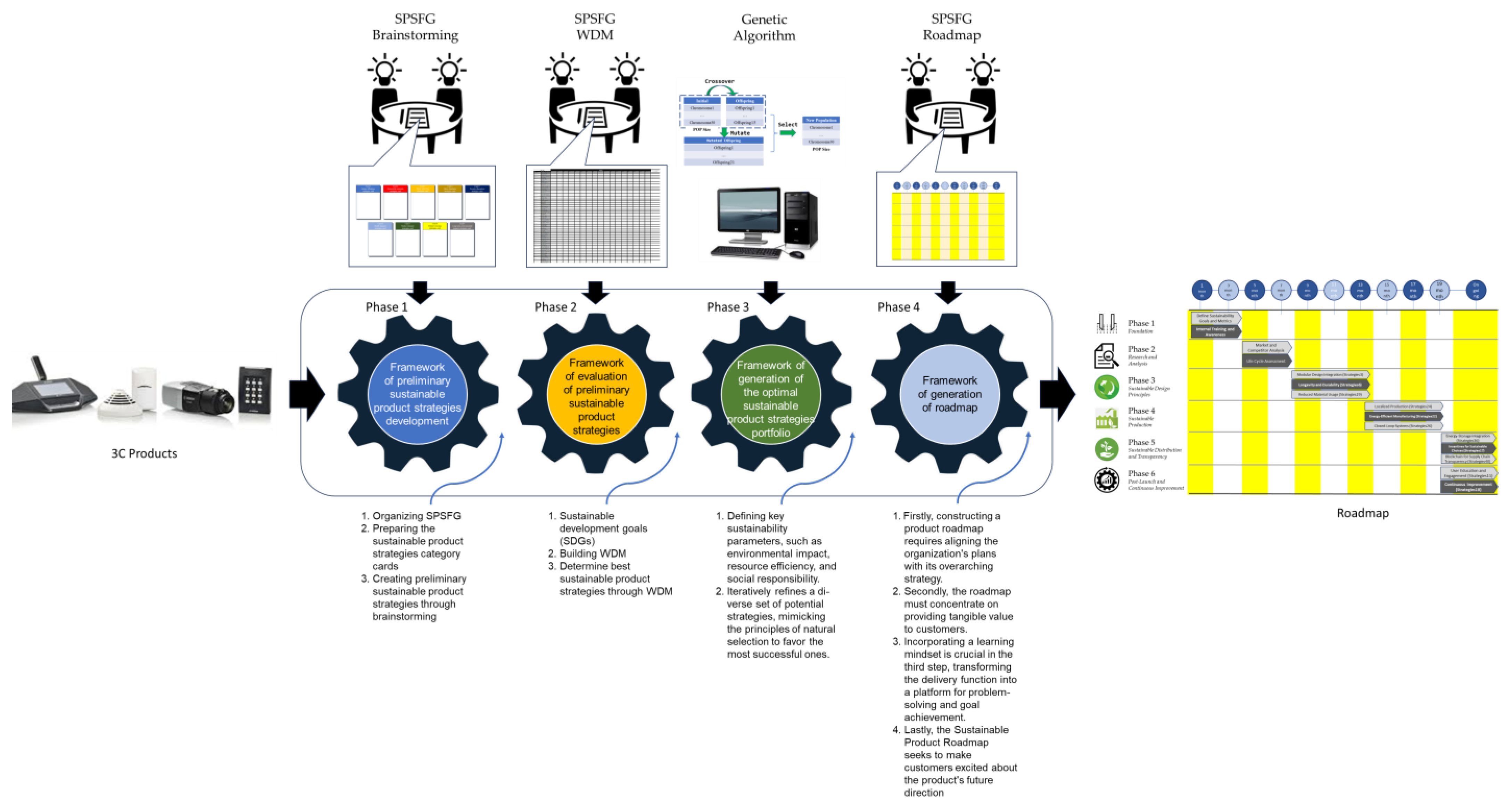
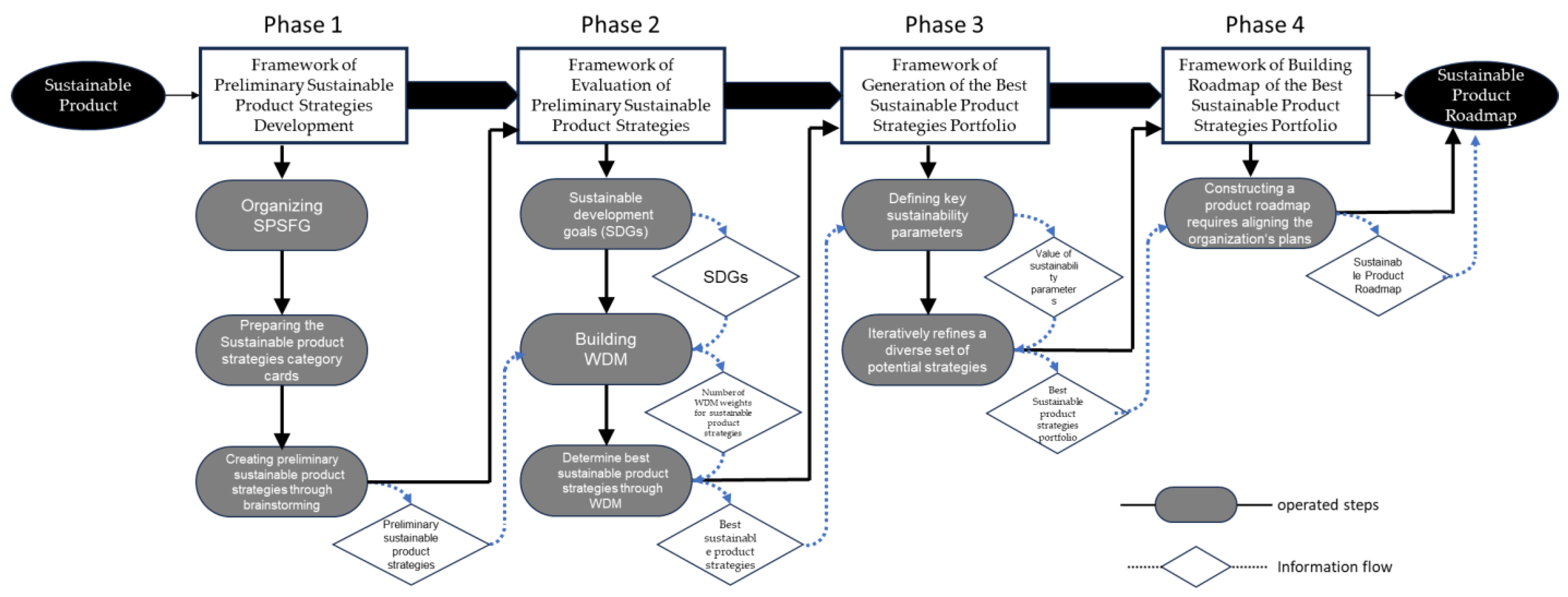
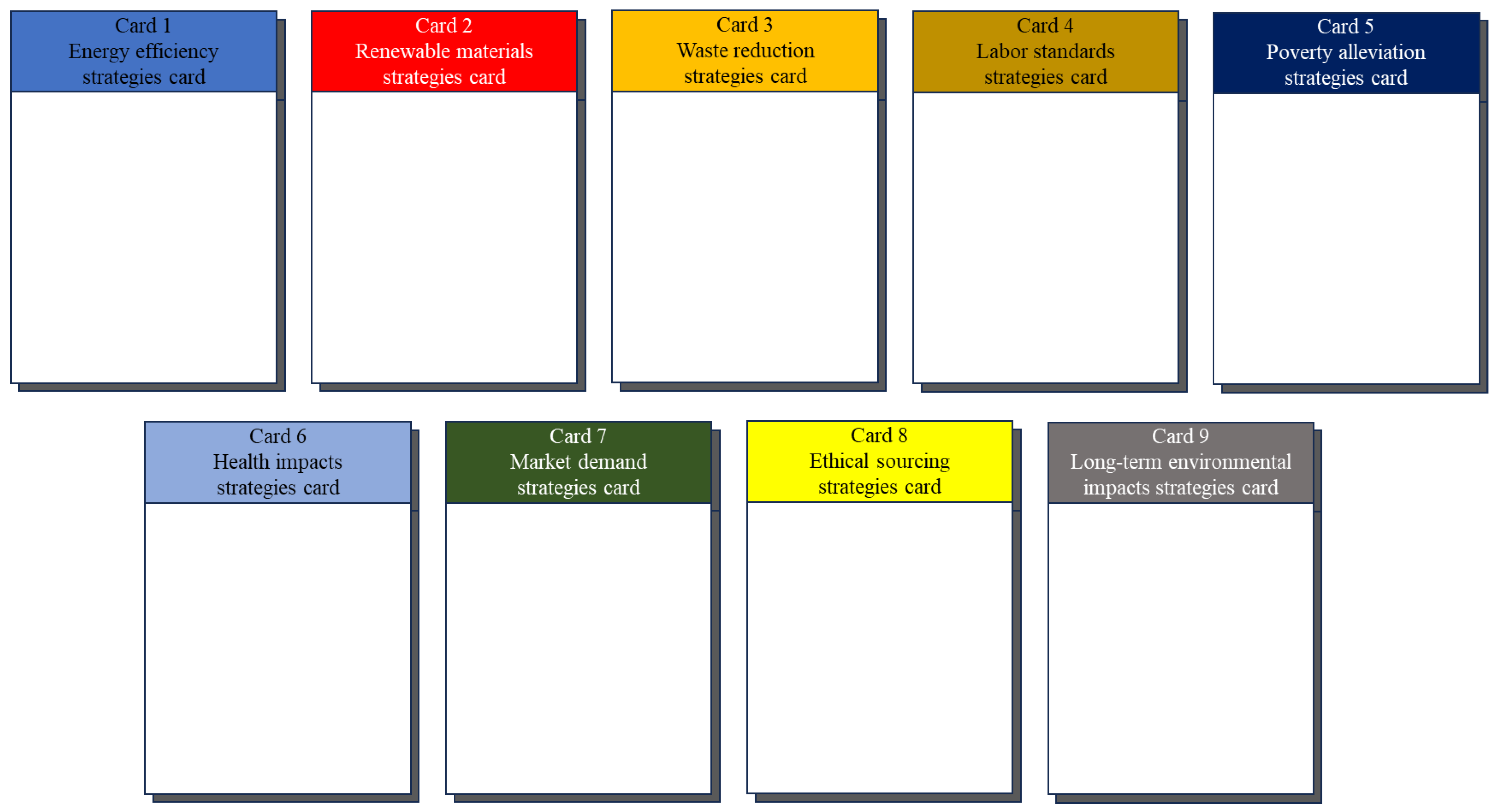
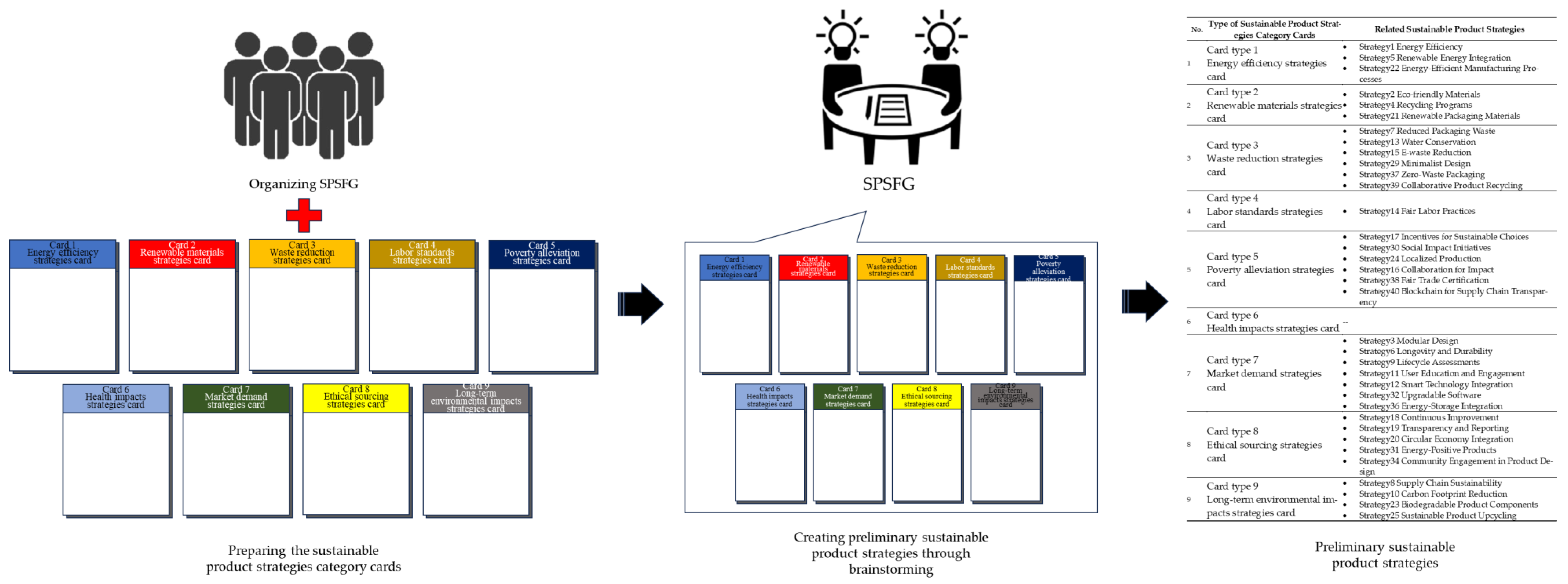
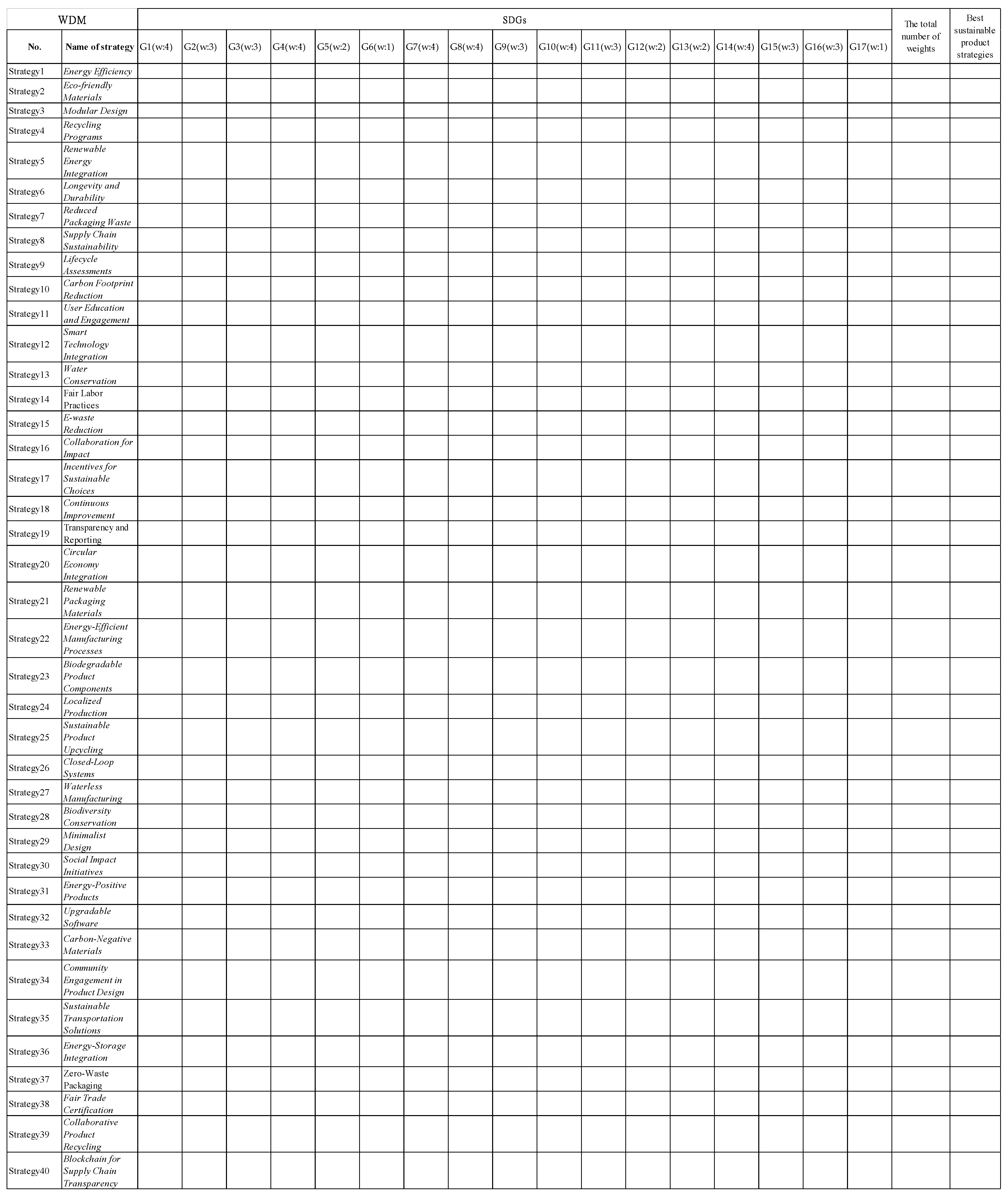
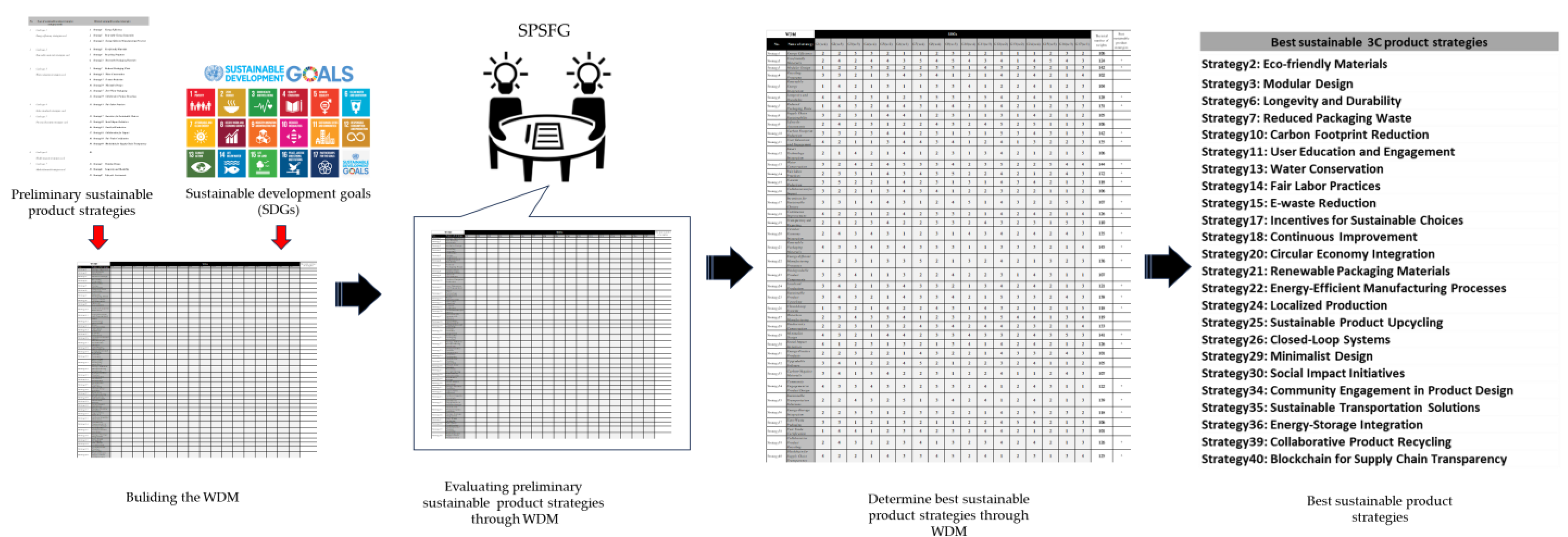
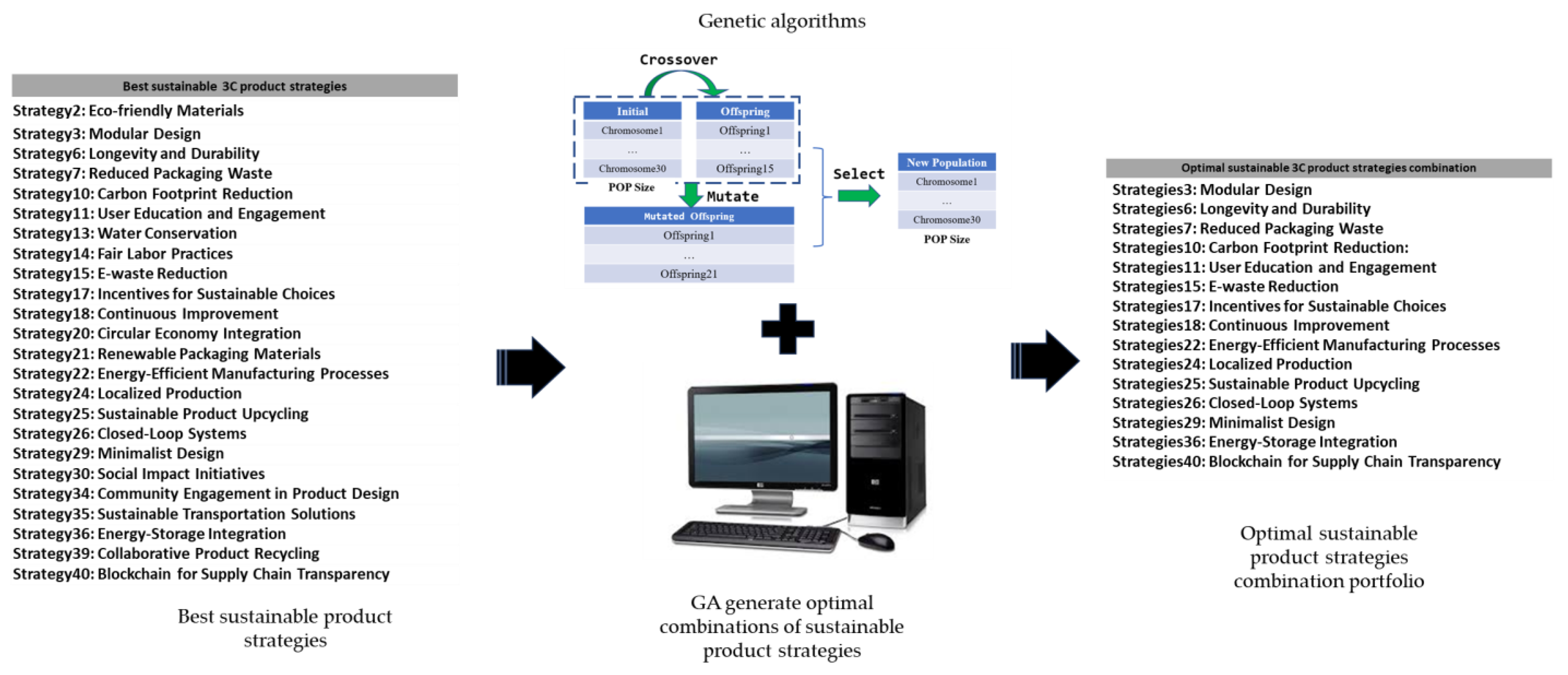
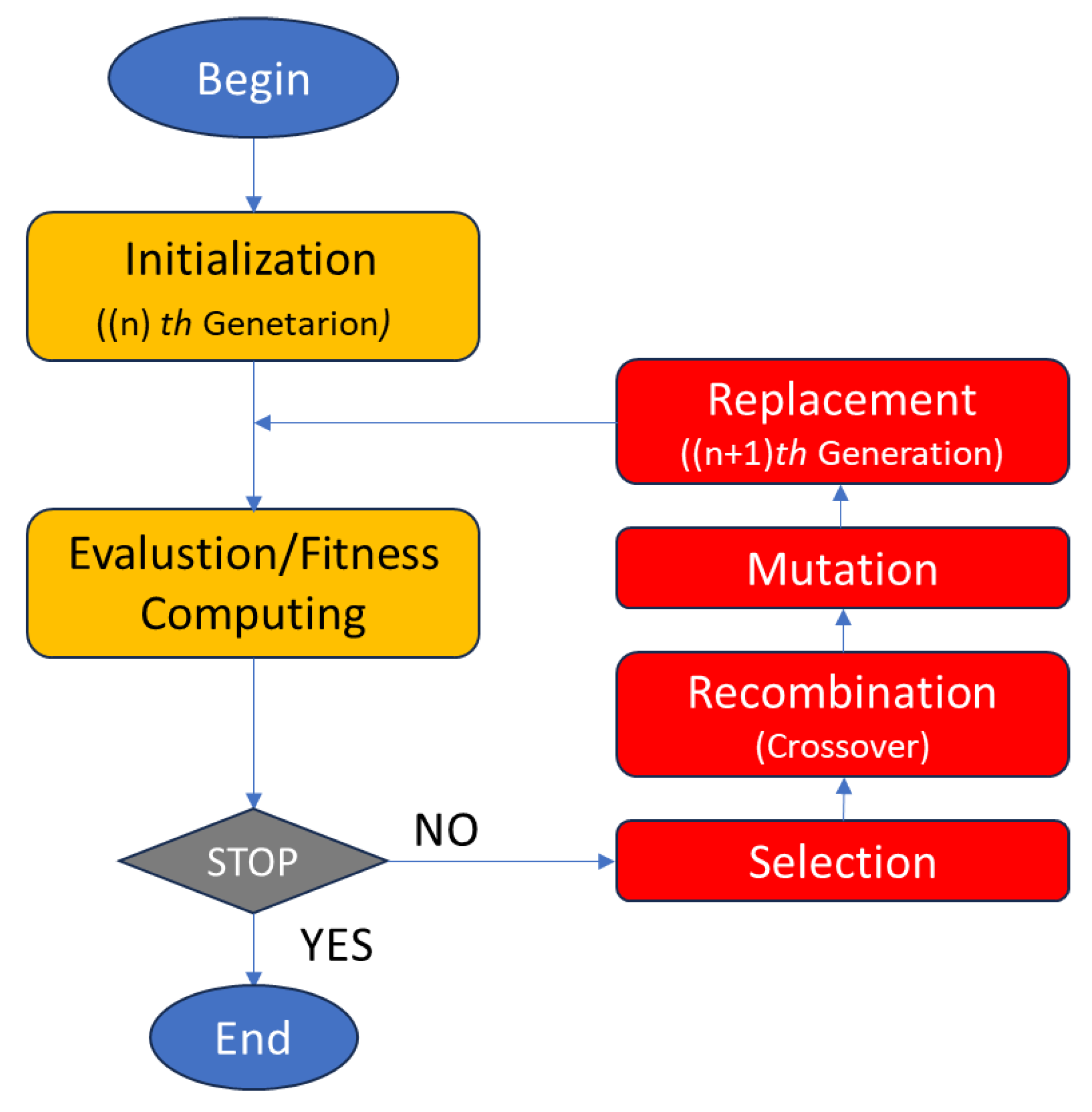


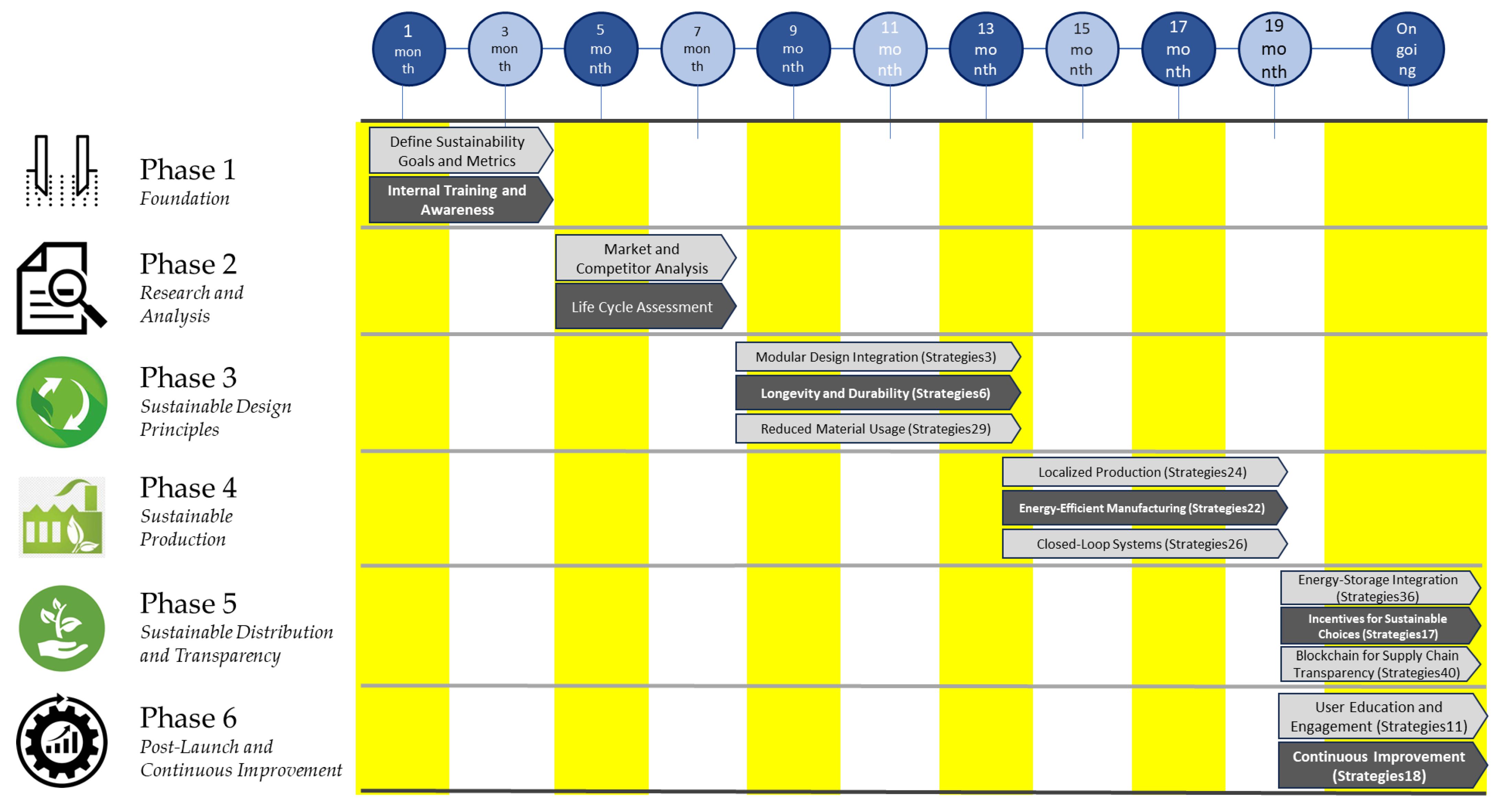
| No1. | Identity | Background |
|---|---|---|
| Member 1 | 3C product designer | 52 years old, 26 years of 3C product design experience |
| Member 2 | 3C product designer | 55 years old, 33 years of 3C product design experience |
| Member 3 | Sustainability strategy expert | 45 years old, 18 years of experience in sustainable strategy research |
| Member 4 | Sustainability strategy expert | 47 years old, 19 years of experience in sustainable strategy research |
| Member 5 | 3C product consumer | 33 years old, 10 years of 3C product purchasing experience |
| Member 6 | 3C product consumer | 31 years old, 13 years of 3C product purchasing experience |
| No. | Type of Sustainable Product Strategies Category Cards | Related Sustainable Product Strategies |
|---|---|---|
| 1 | Card type 1 Energy-efficiency strategies card |
|
| 2 | Card type 2 Renewable materials strategies card |
|
| 3 | Card type 3 Waste reduction strategies card |
|
| 4 | Card type 4 Labor standards strategies card |
|
| 5 | Card type 5 Poverty alleviation strategies card |
|
| 6 | Card type 6 Health impacts strategies card | -- |
| 7 | Card type 7 Market demand strategies card |
|
| 8 | Card type 8 Ethical sourcing strategies card |
|
| 9 | Card type 9 Long-term environmental impacts strategies card |
|
| Best Sustainable 3C Product Strategies |
|---|
| Strategy2: Eco-Friendly Materials |
| Strategy3: Modular Design |
| Strategy6: Longevity and Durability |
| Strategy7: Reduced Packaging Waste |
| Strategy10: Carbon Footprint Reduction |
| Strategy11: User Education and Engagement |
| Strategy13: Water Conservation |
| Strategy14: Fair Labor Practices |
| Strategy15: E-waste Reduction |
| Strategy17: Incentives for Sustainable Choices |
| Strategy18: Continuous Improvement |
| Strategy20: Circular Economy Integration |
| Strategy21: Renewable Packaging Materials |
| Strategy22: Energy-Efficient Manufacturing Processes |
| Strategy24: Localized Production |
| Strategy25: Sustainable Product Upcycling |
| Strategy26: Closed-Loop Systems |
| Strategy29: Minimalist Design |
| Strategy30: Social Impact Initiatives |
| Strategy34: Community Engagement in Product Design |
| Strategy35: Sustainable Transportation Solutions |
| Strategy36: Energy-Storage Integration |
| Strategy39: Collaborative Product Recycling |
| Strategy40: Blockchain for Supply Chain Transparency |
| Optimal Sustainable 3C Product Strategies Combination |
|---|
| Strategy3: Modular Design |
| Strategy6: Longevity and Durability |
| Strategy7: Reduced Packaging Waste |
| Strategy10: Carbon Footprint Reduction: |
| Strategy11: User Education and Engagement |
| Strategy15: E-Waste Reduction |
| Strategy17: Incentives for Sustainable Choices |
| Strategy18: Continuous Improvement |
| Strategy22: Energy-Efficient Manufacturing Processes |
| Strategy24: Localized Production |
| Strategy25: Sustainable Product Upcycling |
| Strategy26: Closed-Loop Systems |
| Strategy29: Minimalist Design |
| Strategy36: Energy-Storage Integration |
| Strategy40: Blockchain for Supply Chain Transparency |
| Sustainable Product Strategies | Content | |
|---|---|---|
| Strategy1 | Material Selection | Choose environmentally friendly and recyclable materials such as FSC-certified wood, recycled metal, and low-emission finishes for OA office furniture. This ensures that the raw materials used are sustainable and contribute to a reduced environmental impact. |
| Strategy2 | Modular Design | Implement modular design principles to allow for easy disassembly and reconfiguration. This promotes flexibility and adaptability, extending the life cycle of the furniture and reducing waste. |
| Strategy3 | Energy-Efficient Manufacturing | Adopt energy-efficient manufacturing processes and facilities. Utilize renewable energy sources and implement lean manufacturing practices to minimize energy consumption during production. |
| Strategy4 | Circular Economy Approach | Embrace a circular economy model by designing OA office furniture with the end of life in mind. Facilitate recycling and refurbishment, encouraging a closed-loop system that minimizes waste and promotes the reuse of materials. |
| Strategy5 | Carbon Footprint Reduction | Evaluate and reduce the carbon footprint of OA office furniture by optimizing transportation methods, sourcing materials locally, and employing energy-efficient logistics. This helps with minimizing the overall environmental impact. |
| Strategy6 | Certifications and Standards | Obtain relevant certifications such as LEED, Cradle to Cradle, or GREENGUARD to validate the sustainability of OA office furniture. These certifications provide transparency and assurance to customers about the eco-friendly nature of the products. |
| Strategy7 | Waste Reduction Practices | Implement waste reduction strategies during both manufacturing and packaging phases. Minimize packaging materials, use eco-friendly packaging, and encourage responsible disposal practices for customers. |
| Strategy8 | Employee Well-Being | Consider ergonomic design principles to enhance the comfort and well-being of employees. Healthy and comfortable workspaces contribute to increased productivity and job satisfaction while aligning with sustainability goals. |
| Strategy9 | Technology Integration | Explore opportunities to integrate smart technologies into OA office furniture. This could include energy-saving sensors, automated climate control, and occupancy sensors to optimize resource utilization and reduce energy consumption. |
| Strategy10 | Supplier Engagement | Work closely with suppliers who share a commitment to sustainability. Collaborate with them to ensure the responsible sourcing of materials and adherence to ethical labor practices, creating a comprehensive and sustainable supply chain for OA office furniture. |
Disclaimer/Publisher’s Note: The statements, opinions and data contained in all publications are solely those of the individual author(s) and contributor(s) and not of MDPI and/or the editor(s). MDPI and/or the editor(s) disclaim responsibility for any injury to people or property resulting from any ideas, methods, instructions or products referred to in the content. |
© 2024 by the author. Licensee MDPI, Basel, Switzerland. This article is an open access article distributed under the terms and conditions of the Creative Commons Attribution (CC BY) license (https://creativecommons.org/licenses/by/4.0/).
Share and Cite
Chen, C.-W. A Framework of Hybrid Method for Developing Optimal Sustainable Product Strategies and Sustainable Product Roadmap. Sustainability 2024, 16, 1374. https://doi.org/10.3390/su16041374
Chen C-W. A Framework of Hybrid Method for Developing Optimal Sustainable Product Strategies and Sustainable Product Roadmap. Sustainability. 2024; 16(4):1374. https://doi.org/10.3390/su16041374
Chicago/Turabian StyleChen, Chun-Wei. 2024. "A Framework of Hybrid Method for Developing Optimal Sustainable Product Strategies and Sustainable Product Roadmap" Sustainability 16, no. 4: 1374. https://doi.org/10.3390/su16041374
APA StyleChen, C.-W. (2024). A Framework of Hybrid Method for Developing Optimal Sustainable Product Strategies and Sustainable Product Roadmap. Sustainability, 16(4), 1374. https://doi.org/10.3390/su16041374






